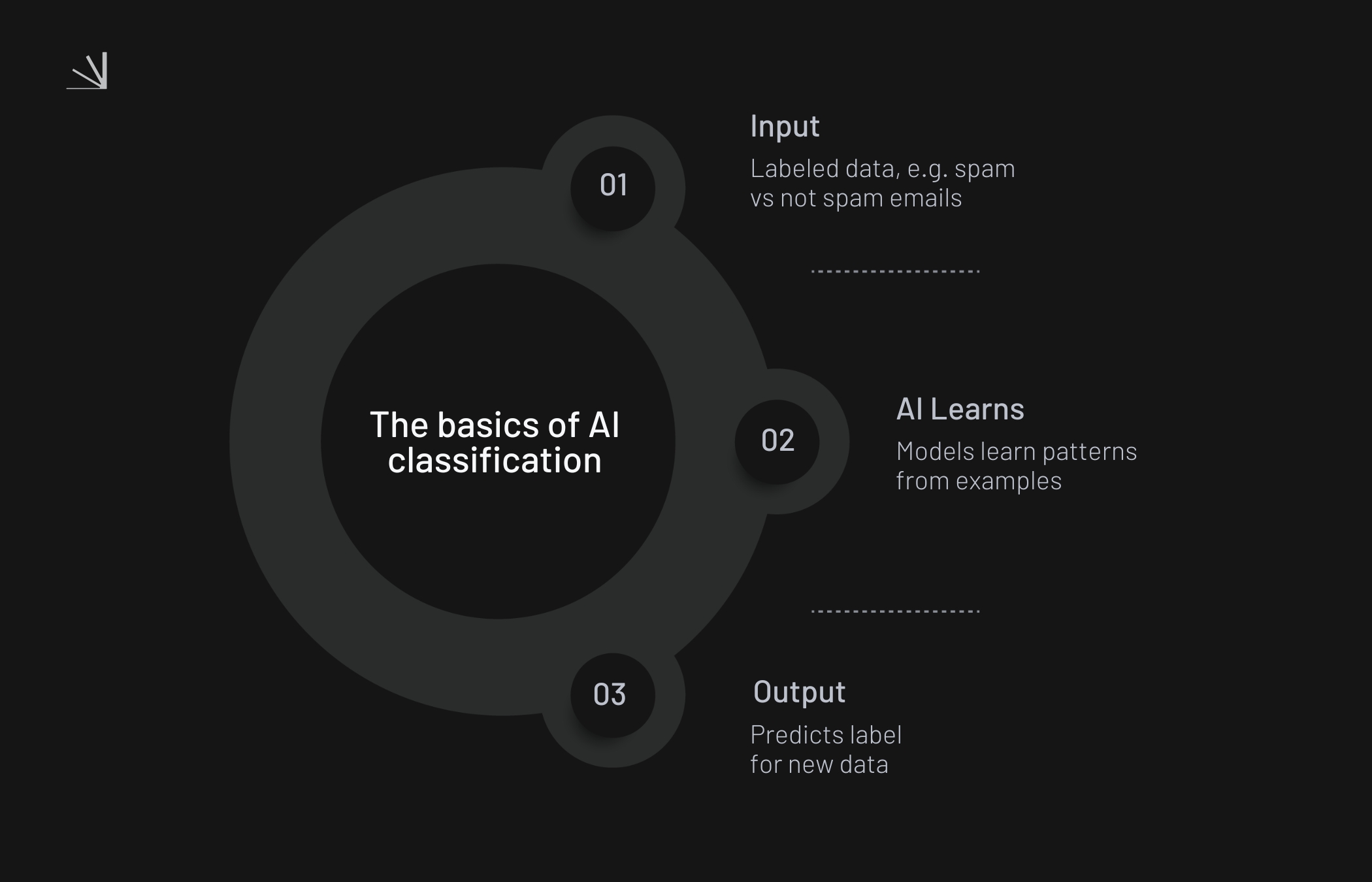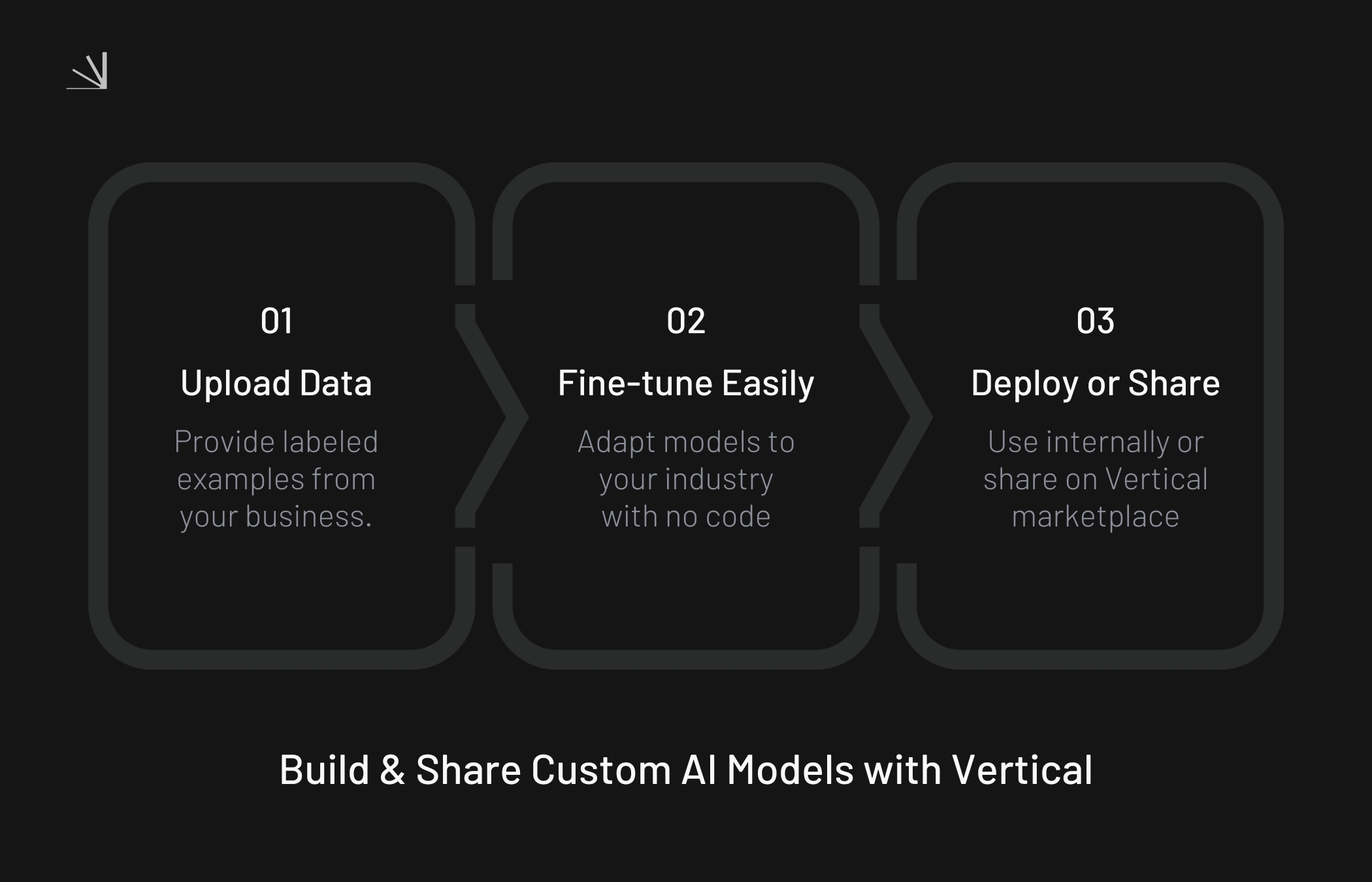What Is AI Classification? Examples, Use Cases, and How It Works
Published on July 17, 2025 · 10 min read

Artificial intelligence is everywhere: writing our emails, recommending what to watch next, and helping businesses make smarter decisions. At the heart of many of these applications lies AI classification, one of the most widely used techniques in machine learning.
In simple terms, AI classification is the process of sorting data into categories. Think of it like a digital librarian: when presented with new information, the system decides where it belongs. From detecting fraud to tagging documents, classification powers countless digital everyday tools.
At Vertical, we make it possible not only to explore AI classification models but also to fine-tune them for specific needs. Whether you’re a business leader, researcher, or creative professional, you can build and deploy models tailored to your unique domain, and even share them on our marketplace.
Classification of AI vs AI for Classification
Before diving in, it’s worth clearing up a common source of confusion when it comes to AI classification:
Classification of AI refers to categorizing AI itself into types of artificial intelligence. Think in the domain of narrow AI, general AI or superintelligence.
AI classification refers to the technical task of assigning labels to data, like predicting whether a customer review is positive or negative.
This article focuses on AI classification as a practical tool you can apply to real problems, rather than the taxonomy of AI itself.
What Is AI Classification?
AI classification is a supervised learning process where algorithms learn from labeled data and use that knowledge to sort new, unseen data into predefined categories.
Key points to understand:
Definition: AI assigns input data to categories (e.g., “spam” vs. “not spam”).
Supervised learning: Models learn from examples where the correct answer is already known.
Narrow AI task: Classification is a focused function, unlike regression (predicting continuous values) or clustering (grouping without labels).
This makes classification one of the most approachable and impactful AI techniques for businesses and creators alike.

How AI Classification Works
The process may sound complex, but it follows a straightforward logic: train an algorithm with examples, then let it make predictions.
Data Labeling and Training Sets
Classification starts with labeled data. For instance, a set of emails marked “spam” or “not spam.” The model studies these examples to learn the patterns that distinguish one class from another.
Model Predictions and Outputs
Once trained, the model can process new data. Given a fresh email, it predicts the label it belongs to. These predictions may be binary (spam or not spam) or multi-class (e.g., sorting images into animals, vehicles, or buildings).
Evaluation Metrics
To measure performance, developers use metrics like accuracy, precision, and recall. In simpler terms, these indicate how often the system gets it right, how reliable it is, and how well it balances different error types.
In short, AI classification is about teaching a system with examples so it can sort new information into the right category. Once trained, the model applies what it has learned to real-world tasks and therefore performs them much better and faster.
Examples of AI Classification in the Real World
AI classification isn’t just theoretical, it is already woven into our daily lives and business workflows. Some practical examples include:
Email spam filters that block unwanted messages.
Sentiment analysis that gauges customer mood from reviews or social posts.
Image recognition that identifies whether a photo contains a cat, dog, or other object.
Document tagging to organize large collections of files.
Fraud detection that flags suspicious transactions in banking.
Language detection that determines the language of a given text.
Each of these shows how classification turns raw data into structured insights or automated actions by sorting them into the right category or label.
Why AI Classification Matters
For businesses and professionals, classification is more than a technical challenge; it’s a genuine driver of transformation. By automating decision-making, it can handle routine judgments like filtering applications or detecting anomalies with speed and consistency. It also fuels personalization, powering recommendation engines that adapt experiences to each individual user.
At the same time, classification helps organizations extract insights at scale by categorizing thousands of customer comments and uncovering patterns that guide strategy. Perhaps most importantly, it empowers creators: with the right tools, even non-technical users can train models to classify product types, detect defects, or organize creative content. In short, classification extends human capability, freeing up time and resources for higher-level work.
Fine-Tune and Use AI Classification Models on Vertical
Vertical goes beyond providing access to general-purpose AI models. We enable you to customize classification models for your own domain, without writing code.
Here’s how it works:
Upload your data: Provide labeled examples relevant to your business or project.
Fine-tune easily: Adjust existing models to recognize patterns specific to your industry.
Deploy or share: Use the model internally, or publish it on the Vertical marketplace where others can benefit from it.

This ecosystem empowers both creators and users. Businesses gain access to highly specialized AI solutions, while creators can monetize their expertise by sharing fine-tuned models. The future of AI isn’t just about bigger models, it’s about more relevant, customized solutions. Classification is one of the best starting points, and Vertical is here to help you make the most of it.




